#Collecting #Christmas #Albums
You’re finally in the Christmas mood. Perhaps you want to trim the tree or wrap presents or indulge in cookies and eggnog. You want the full throwback experience, but you don’t have any Christmas music to spin on your turntable, and you don’t want to hear the same old stuff from the local holiday-hits station. What now?
One of the best parts of collecting Christmas music is that you can obtain a good collection for not a lot of money. Except for music that is collectible for other reasons — for example, doo-wop, punk/alternative, audiophile reissues, 1990s vinyl — most Christmas albums are common and cheap. Many are likely to lurk in the bargain bins at thrift shops and used record stores. But don’t let that deter you! If it’s that old-time feeling you want, the $1-or-less stuff is exactly what you want. Because many of the albums were played only one month a year, even the cheap stuff often is in great shape. Actually, because the albums weren’t always stored with care, a mint-minus cover might be harder to find than a mint-minus record.
For this survey, the focus will be on vinyl albums. Collecting Christmas music on 45 is different; in recent years, some 45s, especially those that still get played on the radio, have become expensive. And CDs are yet another discussion.
In general, Christmas albums fall into two basic categories: various artists collections and single artist records.
VARIOUS ARTISTS ALBUMS
When it comes to the authentic vintage Christmas experience, nothing beats an album with favorite holiday songs performed by numerous different singers. The versions might not be the most famous, but they’ll still be good. With one exception, we’ll focus on those collections put out by the record labels’ special-markets divisions.
In the 1960s and 1970s, the most common way to get such an album wasn’t by going to a record store, but to places that rarely offered music the rest of the year — tire stores, hardware stores, banks and the like. These albums were designed as impulse buys, often kept by the cash registers. This is far from a complete list, but below are four of the most famous series.
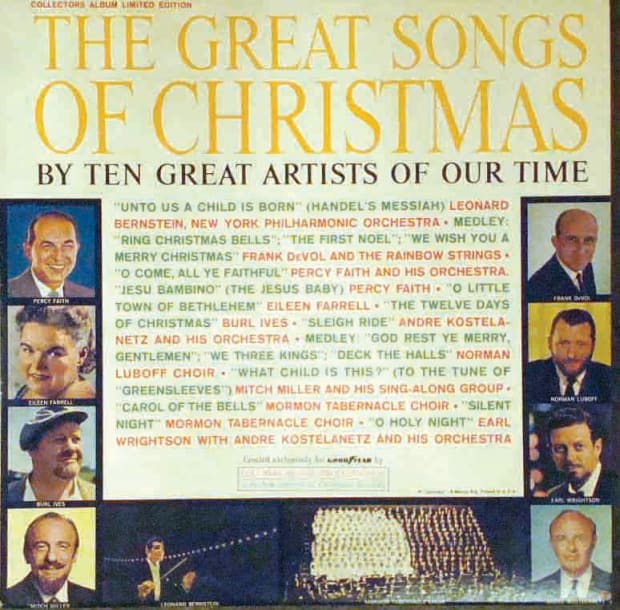
Goodyear
Though a few predated it, the golden age of the Christmas premium album starts in 1961, with The Great Songs of Christmas. Offered at Goodyear tire dealers, it was such a phenomenal success that the press run of 900,000 albums was completely sold out by December 1. This resulted in larger pressings in future years — which is why these albums, cheap in the 1960s, remain common and cheap today.
Goodyear offered a new album every year from 1961 through 1977. The first nine all were consecutively numbered editions of The Great Songs of Christmas. The 10th was Best of the Great Songs of Christmas, with highlights from earlier volumes. Starting in 1971, the Goodyear albums had a different name each year, but they all had the Goodyear logo on the cover.
The first three albums were issued only in mono. Albums four through seven were available in either mono or stereo. All the volumes starting with eight were in stereo only.
As these albums became more popular, Columbia, which released most of the volumes via its Columbia Special Products label, began to have its artists make special Christmas recordings that were, at the time, exclusive to Great Songs of Christmas. The New Christy Minstrels and Tony Bennett are just two examples. For the ninth volume, Goodyear got two new recordings by Petula Clark, who was on Warner Bros. Records in the U.S. at the time.
The 1972 volume, Christmas Is, is worth finding because it marked the first time the Carpenters’ 1970 hit “Merry Christmas Darling” appeared on an album. The song also sounds really good here.
In 1975, the Goodyear albums switched from Columbia to RCA. The first of these was called Henry Mancini Selects Great Songs of Christmas. For two more years, the Goodyear series hung on, but those last two LPs — Mancini Moods at Christmastime, basically a straight reissue of Mancini’s 1966 Christmas album, and The Great Songs of Christmas, with tracks only by Perry Como and the Philadelphia Orchestra conducted by Eugene Ormandy — are relatively hard to locate.
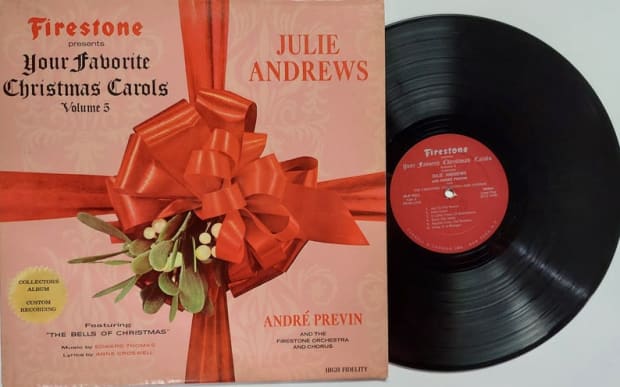
Firestone
A year after Goodyear released The Great Songs of Christmas, its fierce crosstown rival, Firestone, got into the Christmas album market as well. Unlike Goodyear’s approach, the Firestone LPs, under the auspices of advertising jingle firm Forrell & Thomas, were constructed almost as cantatas, with exclusive versions and complete lyrics on the back cover. Seven volumes were issued in this series (1962-68).
In 1966, Firestone pulled off a major coup by landing an entire new Christmas album by Julie Andrews, then all over movie screens as the star of The Sound of Music. This album, with a different order and a couple more songs, was reissued by RCA Victor in 1967 as A Christmas Treasure.
Most of the volumes had slightly different titles each year (Your Favorite Christmas Music was used more than once), but they are all easily identifiable by their package-with-a-bow cover design. The first volume was issued in mono only; the last was stereo only; the others were in either mono or stereo.
The 1967 mono version might be a little harder to find, but otherwise, all seven of these “cantata” albums are common.
After these seven albums, Firestone offered Christmas albums during the 1970s, mostly through Capitol Special Markets. The only way to know these are Firestone LPs, though, is if the shrink wrap is still on the cover, thanks to a red sticker stating “Seasons Greetings Firestone.” Having only a sticker on the shrink made it easier to repurpose those albums that didn’t sell the first time. There may be others, but the four Firestone albums from the 1970s I know of are Christmas America (1973), Christmas America Album Two (1974), The Wonderful World of Christmas (1975), and The Wonderful World of Christmas Album Two (1976). All are common, but finding one with the sticker is harder.
In 1988, Firestone issued a two-record set commemorating the original series titled Your Favorite Songs of Christmas: 20th Anniversary Collectors Album. This is much harder to find than the original seven albums. It also contains nothing from the mono-only 1962 album, nor does it have any of the Andrews tracks.
The “cantata” format for a Christmas album was revived by Hallmark Cards in 1985; that series evolved over time into single-artist albums and lasted well into the CD era. The last Hallmark album on vinyl was in 1991.
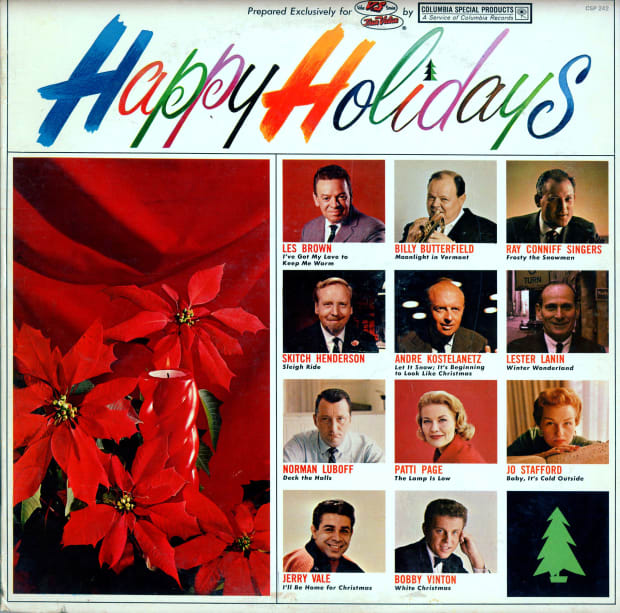
True Value Hardware
After Goodyear and Firestone, the most fondly remembered Christmas series is Happy Holidays, the albums sold by True Value Hardware.
The first Happy Holidays came out for the 1965 Christmas season. Uniquely for its time, it contained both Christmas and seasonal songs in hopes that buyers might play it into January and beyond. After the first two years, True Value dropped the dual-purpose format and went to all Christmas music.
The first volume was released only in mono. Volume 2 came out in both mono and stereo, and all later volumes were stereo.
What Happy Holidays sometimes lacked in heft — many albums had only 10 cuts on them — it more than made up for in longevity; including CDs, the series made it to Volume 40 before it was discontinued after 2005.
It also had a wider variety of artists than most, not only because of how long it lasted, but because it regularly changed labels. In just the first 10 years, Happy Holidays went from Columbia to RCA to Capitol and back to Columbia again.
Volumes 11 and 12, from 1975 and 1976, respectively, consisted entirely of recordings by easy-listening duo Sandler & Young. These sold so poorly that True Value didn’t release Volume 13 until 1978 — and that one went back to the various-artists format that had worked in the past. Volumes 13-22 all came from RCA; Volumes 23 and 24 (1988-89) were produced by MCA’s special-markets division, which allowed “White Christmas” by Bing Crosby to appear on Volume 23 and three Motown Christmas tracks to show up on Volume 24.
Every so often, Happy Holidays would include a Christmas song hard to find elsewhere. Album Six, released on Capitol Creative Products in 1970, contained both sides of Les Baxter’s 1954 single, “Santa Claus’ Party” and “Hang Your Wishes on the Tree.” Volume 19 (RCA Special Products, 1984) is another source for the original 1970 version of “Merry Christmas Darling” by the Carpenters. Volume 21 contained an exclusive, “Have Yourself a Merry Little Christmas” by James Galway, and it also included “God Rest Ye Merry, Gentlemen” by Nat King Cole, which had been deleted from Cole’s Christmas album when it was reconfigured into The Christmas Song in 1963.
The first 25 volumes were released on records. Volumes 1 through 23 are all common, though Volumes 18, 20 and 21 used to have a slightly elevated price because they each contained an Elvis Presley cut. Volume 24, from 1989, is scarce on vinyl, and 1990’s Volume 25, a two-record set with 25 selections, including one from Elvis, is downright rare.
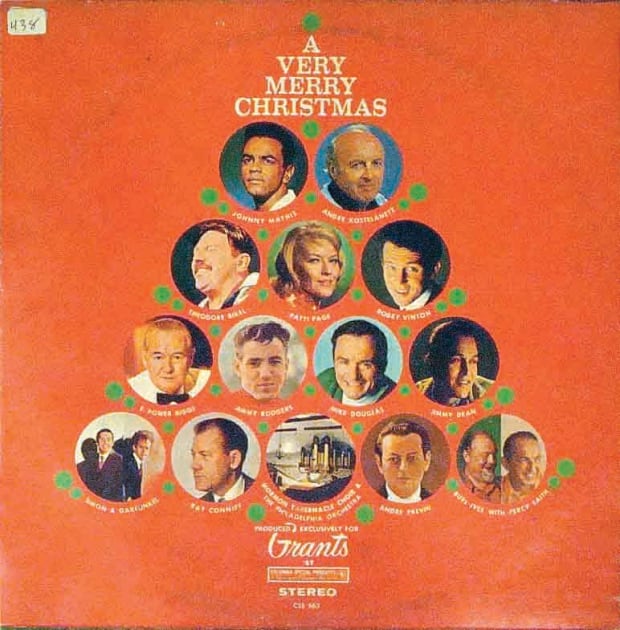
Grants
Grants, also known as W.T. Grant and Grant City, was one of two big five-and-10-cent chains that survived, to some degree, the move from downtowns to suburban shopping centers. In the long run, it was unable to compete with Woolworths and the growing department-store chains such as Kmart. Grants filed for bankruptcy in 1975 and had what was then the largest going-out-of-business sale in American history in early 1976. But before that, Grants had another fondly remembered series of Christmas premium LPs.
Compared to the others in this list, A Very Merry Christmas was a latecomer; the first volume was released in 1967. But its eight albums not only are easy to collect, but are very good.
The first volume, from 1967, is a classic of special-markets releases. For many years, it also was quite collectible even though it is fairly common, because for almost 15 years, it was the only source of the Simon & Garfunkel version of “The Star Carol.” In addition, it contains the seldom anthologized “Sweetest Dreams Be Thine” by Theodore Bikel; it also includes music from such Columbia and Epic artists of the era as Patti Page, Jimmy Dean, Burl Ives and Bobby Vinton, and it closes with the “Hallelujah Chorus” by the Mormon Tabernacle Choir with the Philadelphia Orchestra.
None of the other seven editions of A Very Merry Christmas match that height, but each of them has highlights. For example, Volume 3 has the rare “Christmas Lullaby” by Cary Grant, and Volume 4 contains one uncommon track each by Gary Puckett and Mark Lindsay. But one can see the impending fate of Grants at a glance by noticing the number of tracks on each record; Volume 1 has 14, some of the middle volumes have 12, and Volume 8 has only 10.
Others from corporate America
Many other brands and stores offered Christmas albums to their customers in the 1960s and 1970s. A partial list includes Zenith, the stereo, radio and TV maker; Philco, another electronics brand; JC Penney; Beneficial Finance; Acme Markets, a mid-Atlantic grocery chain; door-to-door cosmetics seller Avon; Ace hardware; several airlines; and many others. A second golden era of store Christmas-music premiums occurred during the CD era; those are beyond the scope of this article.
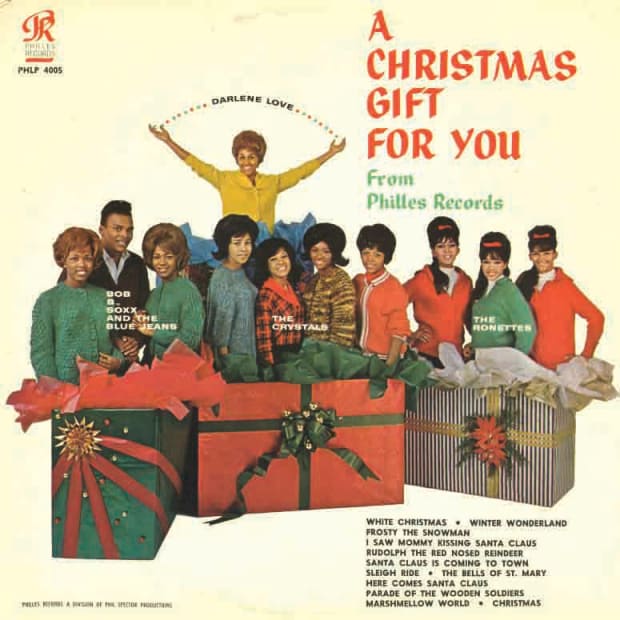
A Christmas Gift for You/Phil Spector’s Christmas Album
Finally, we reach an album that no serious Christmas collector should be without. Indeed, it often makes lists not only of greatest Christmas albums of all time, but greatest albums, period.
Released in 1963 under the name A Christmas Gift for You from Philles Records, it sold decently when first released, contrary to many historians’ belief (it made the Billboard Christmas Albums chart during the 1963-64 season). But most hit Christmas albums were by easy-listening artists in this era, and Phil Spector’s masterpiece was largely ignored the rest of the decade; it ended up in cutout bins by the end of the 1960s.
In 1972, after a few years out of print, Apple Records reissued it as Phil Spector’s Christmas Album, the name it retained until 1987. Every several years, Spector would license the album to yet another American label. Around 1975, the album was released by the short-lived Warner/Spector label; though the front album cover states “Authentic Mono,” this marked the first release of the stereo mix of the LP. Reissues on Pavillion/CBS (1981) and Passport (1984) followed, both of which remained in stereo.
Spector briefly assigned the rights to his back catalog to Rhino, which reissued the classic album in 1987 with the almost original name A Christmas Gift for You from Phil Spector; it also restored it to its original mono. Two years later, ABKCO got the rights and rereleased it yet again. In 1991, the album was included in the vinyl box set Back to Mono, also released through ABKCO. The vinyl version then went out of print.
That is where things stayed until 2009, when EMI-Blackwood Music obtained the rights to Spector’s catalog. Sony Legacy rereleased the CD, while Sundazed reissued the vinyl version. In 2014, a red-vinyl edition was issued for Record Store Day, and in 2016, a white-vinyl pressing was done for Barnes & Noble, while the original black vinyl remained available elsewhere.
In 2020, Sony Legacy reissued the album on vinyl yet again, this time restoring the original name, A Christmas Gift for You from Philles Records, and even using the old blue-gray Philles label on the records themselves.
It’s not likely you’re going to find a copy of this album in a thrift store or a bargain bin; its reputation is too strong for that. For that matter, no matter which version of the LP you obtain, expect to pay a decent price. First editions of the Philles version with a blue-gray label are the rarest by far; a nice copy of the second Philles edition, with the yellow and red label, is more reasonable but still pricey.
For the best sound, I can’t speak to the 2020 version, so not including that, the Sundazed LP is head and shoulders above any prior mono pressing, with Rhino in second place. None of the three stereo editions are all that great, but if you want to hear it that way, the Pavillion/CBS edition is best, and it’s not overly expensive.
SINGLE ARTIST ALBUMS
Hundreds, if not thousands, of artists have recorded Christmas albums. Research is ongoing, but the first Christmas album by a popular (non-classical) artist to consist of all-new recordings appears to be ‘Twas the Night Before Christmas by Fred Waring and His Pennsylvanians, recorded on July 15, 23 and 29, 1942 and released in the 1942 Christmas season as a booklet of four 78s (Decca A-350). That was the same year “White Christmas” by Bing Crosby was first issued as a 78; it was No. 1 on the Billboard best-seller charts by Halloween and stayed there until the beginning of 1943.
The first golden age of Christmas albums didn’t start until the LP size became standardized at 12 inches around 1955. That great era lasted roughly from 1957 through 1967. I will spotlight several artists and their Christmas albums released during those years, selected again for both good listening experiences and, for the most part, ease of locating for cheap.
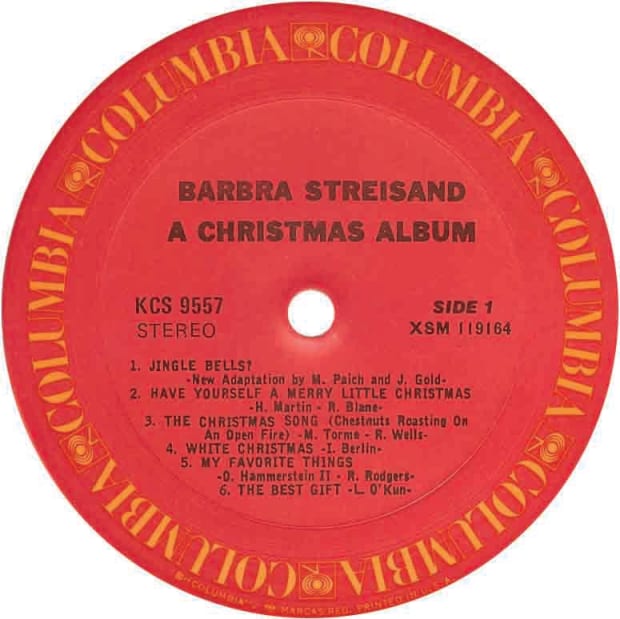
Barbra Streisand
Probably the easiest one-artist Christmas album to find cheap is A Christmas Album by Barbra Streisand. Released in 1967, it was that year’s top-selling new Christmas record, and it didn’t slow down much in the years afterward. It remained in print on vinyl until Columbia discontinued most of its records in 1990.
To this day, most Streisand albums are easy to find, especially her 1960s releases, which were mostly consigned to the album charts and easy-listening stations. A Christmas Album is no exception.
Streisand’s LP is a good, mostly mellow listening experience. It does start with the radical reimagining called “Jingle Bells?”, which some people love and others hate; it might be the most controversial version of that ancient standard among Christmas-music fans, even more so than the Singing Dogs or the “St. Nick” all-laughing version. But from there, it’s smooth sailing. It’s no wonder A Christmas Album sold and sold.
Stereo copies of the album are easy to find, especially on the orange Columbia label in use from 1970-90. Somewhat more difficult, but far from impossible, is an early red-label “2-eye” stereo copy. But when A Christmas Album was first released in 1967, it came out in both mono and stereo; the mono (Columbia CL 2757) was in print only during the 1967 holiday season and is rare.
A related album that also is easy to find is Seasons Greetings from Barbra Streisand…And Friends, a premium album for Maxwell House coffee released in 1969. Side 1 has tracks from A Christmas Album; Side 2 has selections from Jim Nabors, Doris Day and Andre Kostelanetz.
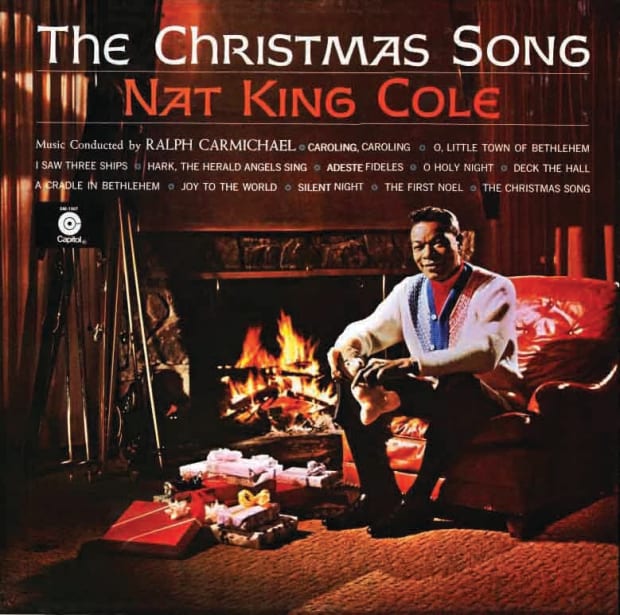
Nat King Cole
With the possible exception of “White Christmas,” no secular song is as evocative of the season as “The Christmas Song (Merry Christmas to You),” first recorded by Nat King Cole as a 78 in 1946. Cole made numerous Christmas singles, both new and covers, from the sublime to the ridiculous, from 1949 through 1958, but he didn’t finally record an entire album of Christmas music until 1960.
Even then, the LP didn’t reach its final, familiar form until 1963. That year, a 1961 rerecording of “The Christmas Song,” made for the three-record retrospective The Nat King Cole Story, was added to the 1960 album, and one track from the original was removed. The final result, The Christmas Song, was immensely popular; it stayed in print on vinyl until 1990, and with the vinyl revival, you can buy a fresh new copy today.
Because The Christmas Song is common, it won’t take long to find a nice used copy for much less than the modern reissue.
The Christmas Song sold well through the years; it can be found on Capitol’s lime-green (1969-71), red (1971-72), orange (1973-76) and yellow budget-line variations — and all those are before the 1980s! Even the original, with the black rainbow-ringed label, isn’t that hard to locate. Slightly more difficult might be a mono copy, as those were in print only until 1967.
Harder to find is the first version of the album. When first issued in 1960, the record was titled The Magic of Christmas. It didn’t include “The Christmas Song,” but it had a rendition of “God Rest Ye Merry, Gentlemen” that was deleted in 1963. This version of the LP was only available for three Christmas seasons, and as a result, it is uncommon. It does pop up periodically, though, so keep an eye out for it.
Another curiosity is the 1966 Capitol Creative Products album The Magic of Christmas with Children, which is unrelated to the original version of Cole’s Christmas album. This one, all copies of which are in mono, contains six of Cole’s pre-1960 Christmas singles. This is the easiest way of finding such songs as “Mrs. Santa Claus,” “The Little Boy That Santa Claus Forgot” and his version of “Frosty the Snowman” on vinyl — and it’s inexpensive, too.
Percy Faith
When it comes to easy-listening Christmas, Percy Faith is at or near the top of the list. He recorded three Christmas albums; two are easy to find and the third is a little more challenging, but not expensive when it shows up.
His first, Music of Christmas, was released in 1954 in mono only. It was so popular that Faith rerecorded it in stereo in 1959; this version remains in print to this day. Even today, the stirring brass fanfare of Faith’s version of “Joy to the World,” the opening number on this album, is a regular feature of Christmas radio.
The second Faith Christmas LP, Hallelujah!, came out in 1958 and was recorded in stereo; this was re-released with the title Music of Christmas, Volume 2 in 1965. His third and final Christmas album, Christmas Is…Percy Faith, was released in 1966. Faith’s first two Christmas LPs contain only the occasional wordless vocal, but Christmas Is has a chorus on most numbers.
The stereo versions of Music of Christmas and Music of Christmas, Volume 2 were in print in various forms through the 1980s; later pressings with either the orange label or special “Columbia Limited Edition” labels are fairly easy to find cheap.
Mono editions aren’t hard to find, either, but both albums sound glorious in stereo, so unless you’re trying to collect both, choose the stereo. An exception: The original Music of Christmas is mono only. This has a cover with Santa Claus holding a sleeping girl; this version of the album was available only from 1954 through 1958. Also, the Hallelujah! version of Faith’s second Christmas album is a bit harder to find than the retitled version, in either mono or stereo.
Christmas Is is still a good album, even if it lacks the majesty of Faith’s first two Christmas LPs. The title song is nice, and the most commonly heard version of “We Need a Little Christmas” is on Christmas Is. Stereo versions aren’t hard to find; the mono version was available for only two years and is tougher.
One less common variation of Faith’s first two Christmas albums is a two-record set with the title The Columbia Album of Christmas Music (Columbia C2L 15). Released in mono only, this gatefold LP was made available during the holiday season of 1958, the same year that Hallelujah! was first released. I’m not sure how long it remained in print, but because the original Music of Christmas was replaced in 1959, I suspect it went out of print fairly quickly.
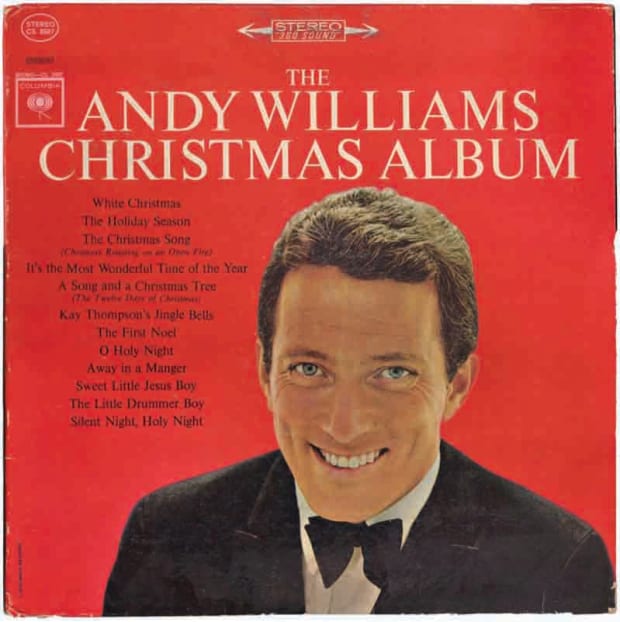
Image courtesy of Goldmine magazine
Andy Williams
This very brief survey of common Christmas albums ends with another bargain-bin staple artist.
The year that A Christmas Gift for You from Philles Records was released (1963), the most popular new Christmas album was The Andy Williams Christmas Album. His version of “The Christmas Song” was released as a single that year, but in the long run, the most popular song on the album was “It’s the Most Wonderful Time of the Year.” That and “The Holiday Season,” a medley with “Happy Holiday,” are staples of Christmas radio.
Only two years later, Williams followed up his first Christmas album with Merry Christmas. It may not have been as instantly memorable as its predecessor, but it does have an arrangement of “Sleigh Ride” that still gets airplay.
These two albums are sometimes known as the “red” and “green” albums, respectively, because of the background colors of their covers. Both stayed in print on record with almost unchanged covers until the end of the 1980s.
Finding clean copies of either album isn’t hard. Even original with “2-eye” labels aren’t too difficult because they sold so well initially. The first edition of The Andy Williams Christmas Album features all-black print and the words “Guaranteed High Fidelity” on the labels; the first stereo version has “360 Sound Stereo” in black. Second editions, and the first editions of Merry Christmas, have “360 Sound Stereo” in white and “Mono” in white on mono copies.
In 1974, Williams recorded a third seasonal album, Christmas Present. It, too, is quite common, but it doesn’t have quite the old-time feel as its 1960s predecessors.
A couple special-products albums prominently feature Williams’ Christmas music. The most common of these is Christmas with Andy Williams and the Williams Brothers, released in 1970 and in print throughout the decade (at least).
